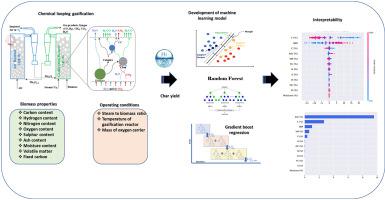Journal of Cleaner Production ( IF 11.1 ) Pub Date : 2023-06-01 , DOI: 10.1016/j.jclepro.2023.137579 Arnold E. Sison , Sydney A. Etchieson , Fatih Güleç , Emmanuel I. Epelle , Jude A. Okolie

|
Chemical looping gasification (CLG) is a promising thermochemical process for the production of H2. CLG process is mainly based on oxygen transfer from an air reactor to a gasification reactor using solid metal oxides (also called oxygen carriers, (OC)) as oxidants. The unique oxygen separation system of CLG makes it an advanced process with a smaller carbon footprint compared to the conventional gasification process. The other advantages of CLG includes increased efficiency, reduced greenhouse gas emissions, and improved process stability compared to conventional biomass gasification. Although CLG is a promising technology, it still faces several challenges such as high capital cost, OC durability, complex reaction mechanism and scalability issues. Some of these challenges can be addressed by understanding the impact of various process conditions on H2 yield and char formation during CLG. The present study proposes a novel integrated process simulation and experimental studies to generate large dataset used for interpretable machine learning (ML) analysis. Three different ML models including support vector machine (SVM), random forest (RF), and gradient boost regression (GBR) were used to develop models for predicting the H2 and char yield during CLG. The GBR outperformed other models for the prediction of H2 and char yield during CLG with R2 value > 0.9. Among the experimental conditions, the temperature (T) and steam to biomass ratio (SBR) were the most relevant parameters affecting H2 and char production. Biomass ash, C, volatile matter (VM) and H content also influenced H2 and char formation. Overall, a combination of SHAP and partial dependence plot helped address the black box challenges of ML models.
中文翻译:

过程建模与可解释的机器学习相结合,用于预测化学循环气化过程中的氢气和焦炭产量
化学循环气化(CLG) 是一种很有前途的用于生产 H 2的热化学过程。CLG工艺主要基于使用固体金属氧化物(也称为氧载体,(OC))作为氧化剂将氧气从空气反应器转移到气化反应器。与传统气化工艺相比,CLG 独特的氧气分离系统使其成为碳足迹更小的先进工艺。与传统生物质气化相比,CLG 的其他优势包括提高效率、减少温室气体排放以及提高工艺稳定性. 尽管 CLG 是一项很有前途的技术,但它仍然面临着高资本成本、OC 耐久性、复杂的反应机制和可扩展性问题等挑战。通过了解各种工艺条件对 CLG 过程中 H 2产率和焦化形成的影响,可以解决其中一些挑战。本研究提出了一种新颖的集成过程模拟和实验研究,以生成用于可解释机器学习 (ML) 分析的大型数据集。包括支持向量机 (SVM)、随机森林 (RF) 和梯度增强回归 (GBR) 在内的三种不同的 ML 模型用于开发用于预测 CLG 期间的 H2和炭产量的模型。GBR 优于其他模型预测 H2和 R 2值 > 0.9的 CLG 期间的炭产量。在实验条件中,温度 (T) 和蒸汽与生物质比 (SBR) 是影响 H 2和炭产量的最相关参数。生物质灰分、C、挥发性物质 (VM) 和 H 含量也影响 H 2和炭的形成。总体而言,SHAP 和部分依赖图的结合有助于解决 ML 模型的黑盒挑战。



























 京公网安备 11010802027423号
京公网安备 11010802027423号